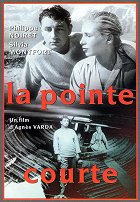Résumés(1)
À Sète, dans le quartier qui borde l’étang de Thau et que l’on appelle La Pointe Courte, un homme revient pour les vacances sur les lieux de son enfance. Il espère faire partager à sa jeune épouse son amour pour ces paysages. Le couple, que mine l’incompréhension, ne s’intéresse guère à l’existence et aux problèmes des habitants du quartier. (Ciné Tamaris)
(plus)Critiques (2)
Varda had practically no experience with films or filmmaking prior to shooting her debut. The geometrically composed shots from unusual angles are inspired by the work of photographers such as Eugène Atget and Henri Cartier-Bresson (Varda herself began as a photographer) and the non-traditional structure, alternating (neo-realistic) anthropological scenes from the life of a fishing village (with non-actors) with lyrical scenes of dialogue by a pair of lovers (with actors) are based on Faulkner’s The Wild Palms. Interrupting the testimony on the difficult economic situation of fishermen and their families with the banal love story of a couple who seem uninterested in the outside world is intentionally frustrating and leads us to contemplate the relativity of the problems that seem significant to us in our lives. As in most of Varda’s subsequent works, the film’s dominant feature is contradiction, in this case particularly the contradiction between the social and the personal, documentary and performed. ___ The editor of the original, and in some ways slightly naïve and awkward, film was Alain Resnais, who introduced Varda to the cinephiles from the Cahiers du Cinéma clique and recommended that she start visiting the Cinémathèque in Paris. Though she did not know Visconti or any of the other directors whose influence contemporary reviewers perceived in her debut, she in fact surpassed the New Wave when she was the first to circumvent the system (it was common in France at that time to advance to the position of director through many years of serving as an assistant) and made a feature film very cheaply according to her own ideas, while rejecting the convention of formally staid and, in terms of reality, distant “dad cinema”. 70%
()
Personne ne pourrait associer immédiatement la Belge Malou avec la Nouvelle Vague ni avec ses débuts (il fallait la solidarité d'un groupe d'hommes prêts non seulement à tourner de nouveaux films, mais aussi à proclamer avec fierté leur entrée dans l'histoire du cinéma). Malgré cela, son premier film fait sans aucun doute partie d'une nouvelle ère, ayant peu en commun avec les autres films des années 50 (en effet, pourquoi le premier film de Truffaut devrait-il être considéré comme le début symbolique du mouvement, tandis que "La Pointe courte" ne devrait pas l'être ?). Des mouvements de caméra fluides, des montages vifs, aucune enjolivure embarrassante, la misère sans mélancolie ni moralisation, un amour insaisissable et éternellement en fuite vers un ailleurs où il sera à nouveau (re)découvert, des dialogues entre amants qui requièrent une réflexion (montrez-moi un tel film des années 50, voire antérieur, et je vous en serai très reconnaissant !), un film entre fiction et documentaire sans aspiration à transformer l'histoire en conte de fées ou en accusation, un film qui coule paisiblement, se termine doucement mais crescendo. Ce film partage avec les années 50 seulement les quatre chiffres de sa date de création.
()

